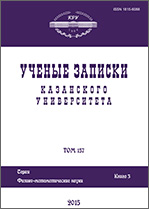|
|
Uchenye Zapiski Kazanskogo Universiteta. Seriya Fiziko-Matematicheskie Nauki, 2013, Volume 155, Book 3, Pages 19–35
(Mi uzku1211)
|
 |
|
 |
This article is cited in 1 scientific paper (total in 1 paper)
Lunar studies at Kazan university: trends, results and prospects. I. Physical libration
N. K. Petrovaa, Yu. A. Nefedevab, S. A. Deminb, A. V. Gusevc
a Engelhard Astronomical Observatory, Kazan (Volga region) Federal University, Kazan, Russia
b Institute of Physics, Kazan (Volga region) Federal University, Kazan, Russia
c Institute of Geology and Petroleum Technologies, Kazan Federal University, Kazan, Russia
Abstract:
The main results of the lunar physical libration investigations at Kazan University are presented in the article. The modern problems in the lunar spin-dynamics are considered. Much attention is paid to the finest effects of lunar libration, caused by its complicated interior structure. The parameters of the free libration of the Moon are discussed; a geometrical interpretation of the chandler-like wobble and the free core nutation is given. The targets and problems of the future Japanese project ILOM (In situ Lunar Orientation Measurement) are briefly described in the article. As part of the project it is planned to place a small optical telescope on the lunar surface with the purpose of detecting the lunar physical libration with millisecond accuracy. The computer simulation of the future observations is carried out for their optimization (efficient placement of the observation equipment on the lunar surface; testing of the sensitivity of the new observations to various features of the lunar interior structure). The results of the first stage of the simulation are presented in the paper. At this stage the software for the selection of stars and the reduction of their coordinates for the observation period is developed. The tracks for the selected stars are constructed and analyzed, and their sensitivity to the internal characteristics of the lunar body (in the first place, to the selenopotential coefficients) is tested.
The inverse problem of the physical libration is formulated. It is shown that observations of polar stars do not allow of determining libration in longitude $\tau(t)$. At the stage of solving the inverse problem, the manifestation of the viscoelastic properties of the Moon in the selenographic coordinates is investigated. In the spectrum of simulated residuals, those harmonics are identified which can serve as indicators to refine the viscoelastic parameters such as the Love number $k_2$ and the anelastic time delay.
Keywords:
lunar physical libration, free and arbitrary libration, lunar core, ILOM, lunar polar telescope, observations, computer simulation.
Received: 18.07.2013
Citation:
N. K. Petrova, Yu. A. Nefedev, S. A. Demin, A. V. Gusev, “Lunar studies at Kazan university: trends, results and prospects. I. Physical libration”, Uchenye Zapiski Kazanskogo Universiteta. Seriya Fiziko-Matematicheskie Nauki, 155, no. 3, Kazan University, Kazan, 2013, 19–35
Linking options:
https://www.mathnet.ru/eng/uzku1211 https://www.mathnet.ru/eng/uzku/v155/i3/p19
|

|




 Contact us:
Contact us: Terms of Use
Terms of Use
 Registration to the website
Registration to the website Logotypes
Logotypes








 Citation in format
Citation in format 
